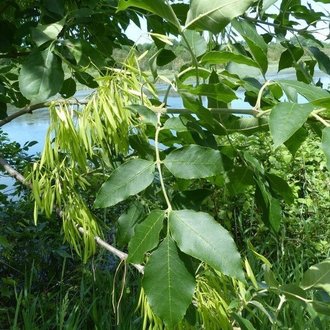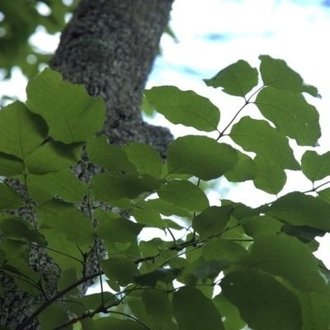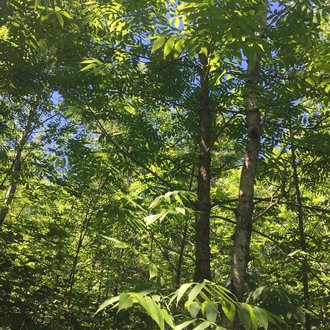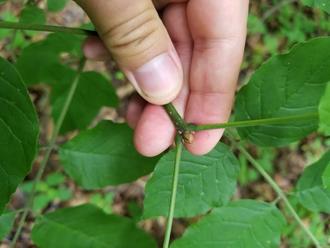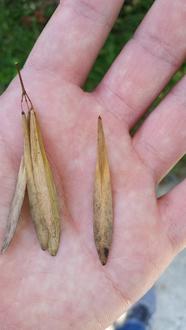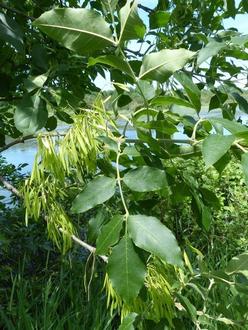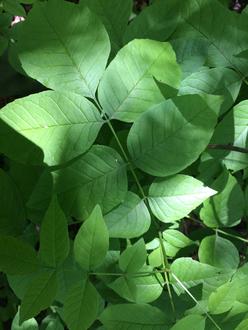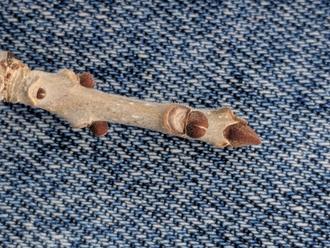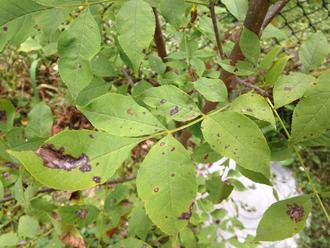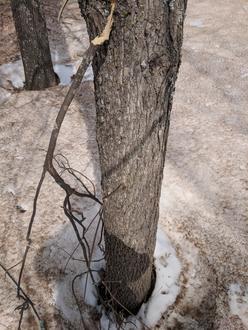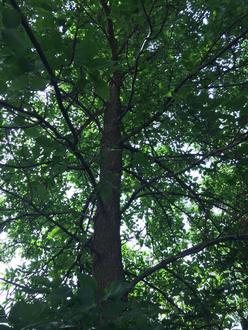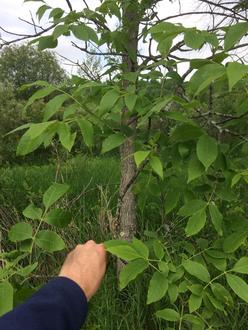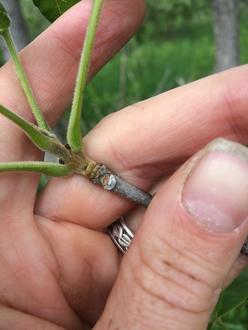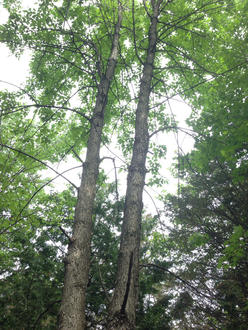Green Ash (Fraxinus pennsylvanica Marshall)
Also known as red ash.
↑Summary
A widely-distributed tree found mostly in floodplains, riparian areas, and swamps, and occasionally found on drier sites; severely threatened by the emerald ash borer.
↑Range - Expand
| Legend | Color |
| Native | |
| Introduced | |
| Present: Various or Uncertain Origin | |
| Native or Not Present | |
| Introduced or Not Present | |
| Native or Expanded | |
| Native or Introduced or Not Present |
This map is based on our research. We have checked its accuracy to Level 3 ecoregions. Although this plant occurs somewhere in each of these regions, it may only occur in a small part of some or all of them.
↑Description & Identification
A tree, growing to 100 feet in parts of its range but about half that in the western and far northern portions of its range. The trunk is straight, and often has an enlarged base when growing on flood-prone sites.
Leaves are oppositely arranged and pinnately compound, with 5-9 leaflets. Leaflets are usually tapered at the base and sometimes have a small winged stem attaching to the central stalk of each leaf.
Fruits are samaras, borne in clusters, containing a single seed each; seed is narrow and cylindrical, standing out against the flat wings of the samara, and takes up about half the length of the samara.
Bark of mature trees consists of interlacing vertical ridges, forming numerous diamond shapes. Terminal buds are flush up against nearby lateral buds. Leaf scars tend to be flat on top, with the adjacent bud atop the scar, not usually in a deep notch.
↑Similar Plants
↑Habitat
Most frequently found in wet, poorly-drained areas, including floodplains, riparian areas, and swamps, but occasionally found in drier habitats with more average moisture conditions, especially as a pioneer species. Tolerates a wide range of soil types, ranging from poorly-drained to well-drained. Less frequent and grows less vigorously on coarse, sandy soils, and only found on these soils if near a source of water. Tolerant of alkaline soils and often found on calcareous soils. Found on sites that flood temporarily, but not tolerant of continuous flooding.
However, not usually found on soils that have been cultivated, especially those cultivated for a long time, so usually absent from or uncommon on abandoned agriculture. However, sometimes found in agricultural areas in shelterbelts and windbreaks.
Occupies different successional stages, depending on conditions and location. On well-drained sites protected from disturbance, in the northeast, green ash is only a pioneer species. However it can persist longer on poorly-drained sites and other low-lying sites that flood regularly, and it can be found in old growth forests on such sites.
↑Life Cycle
Green ash is a fairly weedy tree that grows rapidly, produces prolific seeds, and can also reproduce vegetatively.
Seedlings establish best in partly-shaded sites, in moist soil or litter. Seedlings are able to survive some flooding, including up to two months of water 1 inch above the soil, and seedlings may even grow faster in saturated soil than in more well-aerated conditions. However, seedlings are killed by prolonged, deeper flooding that covers them.
Green ash is highly tolerant to browsing by mammals, including both wild animals and livestock. Although heavy browsing does kill a significant number of seedlings, a significant number of seedlings can survive to maturity even with browsing.
Trees tend to experience multiple flushes of growth in one season, and growth rates are often higher on sites that experience greater flooding.
This species is dioecious, with male and female flowers borne on separate trees. Flowers are wind-pollinated. Trees may flower and produce some seed when they reach about 3-4 inches in diameter, but significant seed production usually begins when trees reach 8-10 inches in diameter. Patterns of seed production are variable by site and conditions, with some trees producing consistent seed every year, but others producing less seed in a typical year and having bumper crops at intervals every 5 years or even longer.
Seeds are primarily distributed by wind, but dispersal may also be aided by water, especially given this species' propensity to be found in wetlands. Seeds shed in winter typically travel farthest from the parent tree, especially when they fall on crusted snow.
Seeds require a period of cold dormancy, and germinate only in the following spring. This species can form a short-term seed bank, typically up to 3-4 years, depending on conditions. In some areas and conditions, there is no seed banking. Seeds can germinate in flooded conditions.
Trees resprout vigorously following disturbance, including fire, logging, or damage from flooding.
Trees can live to 200-250 years, but are often shorter-lived.
↑Faunal Associations
The foliage is eaten by deer, mostly in May, and low-growing trees are also browsed by rabbits. Beavers rely on green ash stems for food in winter. The seeds are eaten by numerous birds, including finches, blackbirds, and many larger birds, as well as by small mammals.
↑Uses
Prior to the introduction of the emerald ash borer, this species was fairly widely used in landscaping as a shade tree and sometimes a street tree. It was valued for its rapid growth, tolerance of wet soil, air pollution, and deer browsing, and generally being easy to grow on a variety of sites.
↑Related Plants
Green ash is closely related to numerous other ash species of North America. It is probably most closely related to velvet ash (Fraxinus velutina) and mexican ash (Fraxinus berlandieriana), which are only found in the southwest, and pumpkin ash (Fraxinus profunda), which overlaps with it in range in the east but is less common. It is also closely related, but in order of decreasing closeness, to the Carolina ash (Fraxinus caroliniana) and the West coast's Oregon ash (Fraxinus latifolia), the Chihuahuan ash (Fraxinus papillosa), shamel ash (Fraxinus uhdei), and white ash (Fraxinus americana).
Hybridization with white ash has been reported in Michigan, but is considered rare, in spite of the fact that these species overlap greatly in range and often occur near each other in some habitats.
↑Notes
This species is severely threatened by the emerald ash borer, an introduced insect, which seems to prefer this species over others. The borers tend to kill about 99% of mature trees. There is hope that the aggressive reproduction of this species, with rapid growth and high seed production, will help it adapt to develop resistance to this insect.
The red ash is usually considered a subspecies of this species, Fraxinus pennsylvanica var. pennsylvanica. However, we recommend avoiding the use of that common name because it is ambiguous, also potentially referring to the pumpkin ash (Fraxinus profunda), which overlaps with that variety in range. Not all authors even recognize varieties or any sub-taxo of this species.
↑Links & External Resources
• Green Ash | The Wood Database (About This Site)
• Green Ash | Fire Effects Information System (FEIS) (About This Site)
• Fraxinus pennsylvanica (Green Ash) | USDA PLANTS Database (About This Site)
• Fraxinus pennsylvanica | Go Botany (About This Site)
• Fraxinus pennsylvanica (Green Ash) | Missouri Botanical Garden Plant Finder (About This Site)
• Green Ash | Virginia Tech Dendrology Factsheets (About This Site)
• Green Ash | Silvics of North America (About This Site)
• Fraxinus pennsylvanica | Biota of North America Project (BONAP) (About This Site)
• Fraxinus pennsylvanica | NatureServe Explorer (About This Site)
• Green Ash | Maryland Biodiversity Project (About This Site)
• Fraxinus pennsylvanica Marshall (Green Ash, Red Ash) | Digital Atlas of the Virginia Flora (About This Site)



